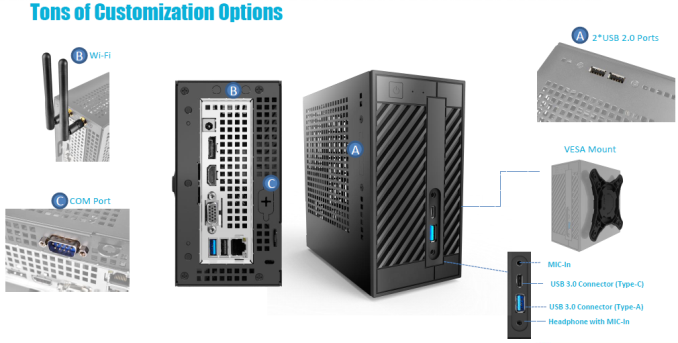ASRock DeskMini 110 mini-STX PC Review
by Ganesh T S on June 8, 2016 8:45 AM ESTConcluding Remarks
The ASRock DeskMini 110 gave us the opportunity to check out what is possible with the mini-STX form factor and a high-TDP Skylake CPU. It is quite clear that Intel's current marketing angle with the mini-STX form factor is affordability. Otherwise, it is difficult to explain why almost all vendors have gone in for a H110 chipset-based design for their mini-STX offerings. That said, ASRock has put in a couple of good differentiating aspects in the DeskMini 110: support for 65W TDP CPUs and a M.2 PCIe slot for SSDs directly connected to the CPU's PCIe lanes. This works around the issue of the H110 chipset having only PCIe 2.0 lanes
The pricing is very competitive - $130 for the all-metal chassis, 120W power adapter and cord, and the H110 motherboard. While the assembly is not as easy as that of a NUC, it is acceptable for the DIY market.
In terms of scope for improvement, a bundled WLAN adapter would be very welcome. Sourcing one that can fit in with the chassis design will be a challenge, as most M.2 PCIe WLAN modules are either meant for NUCs, or for notebooks. The DeskMini's all-metal chassis makes it difficult to get a suitable placement for the flat antennae that come with such WLAN adapters. I think it would be better for ASRock to bundle / pre-install a WLAN module and antennas for a slight increase in the price of the product. The DeskMini could also do with some additional I/O (say, a SD card reader).
It is great to see the mini-STX form factor getting broad vendor support. We would like it more if vendors were able to differentiate their offerings. ASRock has tried out a few things differently in the storage subsystem and chassis design with the DeskMini 110. We look forward to seeing what other differentiation aspects come out in the future iterations in this product line.












85 Comments
View All Comments
aethertron - Sunday, June 12, 2016 - link
I'm new to this, does the i5 HQ version draw the same power and get the same clock as the 65 W desktop version? I was thinking of this form factor because I was hoping to put full-power desktop components in a smaller form factor.extide - Monday, June 13, 2016 - link
That IS a full power normal desktop CPU, like you can buy at newegg.Gadgety - Wednesday, June 8, 2016 - link
@TS Ganesh " larger than the NUCs, but smaller than a mini-ITX build"Why do you not list case dimensions in the specifications as this is part of the point of evaluating this offering?
t.s - Wednesday, June 8, 2016 - link
seconded. A review about SFF, without the dimension is quit funny.ganeshts - Wednesday, June 8, 2016 - link
Approx. 6.125" x 6.125" x 3.125" by rough measurements. That comes to ~1.9L, but ASRock claims 1.82L in their press release. I might be off by 0.1" or so in the hurried measurements that I took.Btw, you can get an idea of how small the case is from the photo here: http://www.asrock.com/news/index.us.asp?id=3303
Gadgety - Wednesday, June 8, 2016 - link
Thank you.fanofanand - Wednesday, June 8, 2016 - link
Thank you Ganesh, I am awful at visualizing dimensions, that picture changes my entire opinion of this device. I went from simply being bummed about the PCI-e being at 2.0 speeds to being stoked at the possibilities. I am still holding out hope for a usable (FB, Youtube etc.) USB stick PC, but I may give up waiting (will likely be years for that to be realized) and just go for something like this. Great article Ganesh!QChronoD - Wednesday, June 8, 2016 - link
I was expecting to see a picture of this next to a modular PSU with the caption of "Can you guess which is which?"Michael Bay - Saturday, June 11, 2016 - link
Same here, looks just like a fancy PSU would.Eden-K121D - Wednesday, June 8, 2016 - link
Where is the GTX 1080 review ?